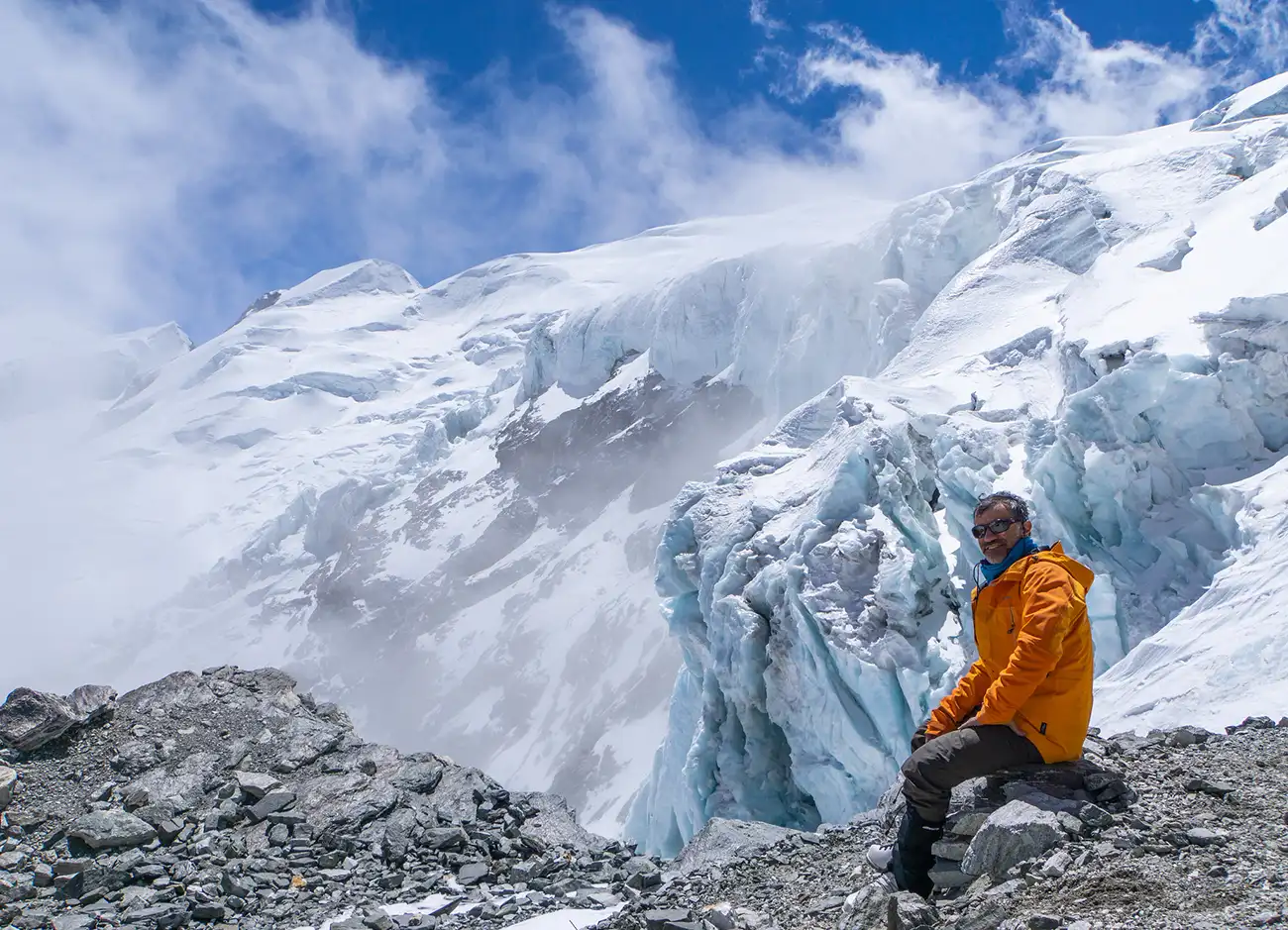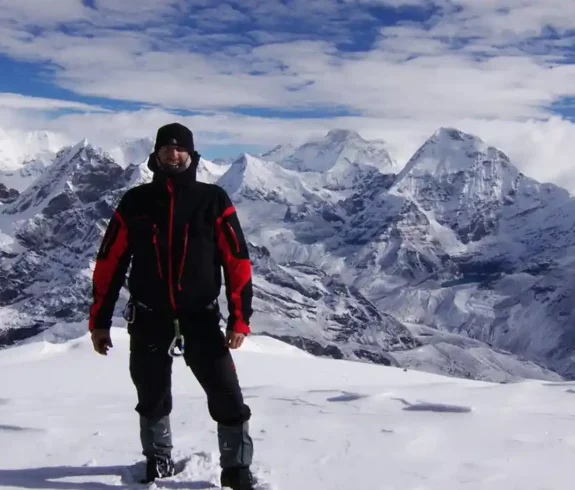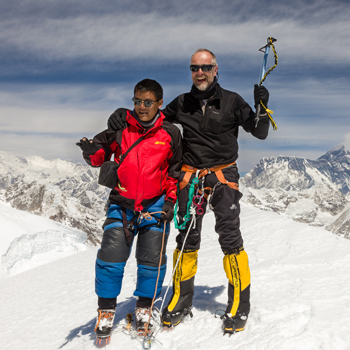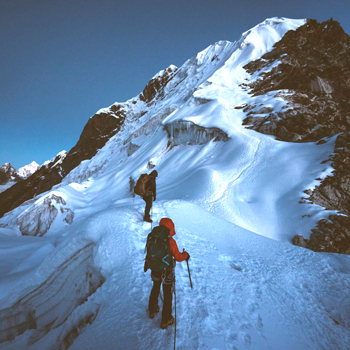Mera Peak is Nepal’s most beautiful trekking peak, situated at an altitude of 6476 meters (21,247 feet). The peak is within the Solu Khumbu Region and offers a gripping expedition full of pleasant sights from the Everest, Lhotse, and Makalu ranges. Climbers of all levels experience it almost equally since it is less technical than all the regional peaks. However, understanding the best time to climb Mera Peak is crucial to ensure a safe and successful ascent.
The season you select for your climb affects your overall experience significantly. The year’s seasons can vary regarding weather, trail conditions, and safety, so one must consider this when planning. Below are key points that highlight why selecting the Best Time to Climb Mera Peak matters:
Importance of Choosing the Best Time to Climb Mera Peak
- Weather Stability: Climbers avoid rocky faces and appreciate clear blue skies with little or nothing hanging over them. The best seasons, spring and autumn, are not very erratic, reducing the chances of impromptu storms or blizzards.
- Safety Considerations: Extreme temperatures may affect the condition of the trails, causing leading risk factors such as landslides and wet surfaces. They feature relatively less climbing risk and are safer for climbs during the recommended seasons.
- Trail Conditions: There are peak seasons when the trail is well-kept and easy to use. Thus, choosing when these paths are available with little snow, rain, or ice is essential, making them risky.
- Climbing Experience: If one gets their timing right, climbing becomes enjoyable. A climber will get to climb when the weather is good, climbing will have excellent vistas, and extreme heat or cold will not be experienced.
- Crowd Management: The peak seasons bring more climbers, which can lead to a lively atmosphere but may also mean crowded routes. On the other hand, off-season climbs offer solitude but come with challenging weather. Knowing when to go helps balance these factors based on personal preference.

Best Time to Climb Mera Peak
The best time to climb Mera Peak is Spring (March-May) and Autumn (September-November). These two seasons offer ideal weather conditions, making the ascent safer and more enjoyable. In spring, temperatures are mild, and the weather remains stable, allowing climbers to navigate the trails comfortably. The vibrant landscapes and blooming flora add to the scenic beauty, enhancing the trekking experience.
Autumn is another favorable season, known for its clear skies and cool, crisp air. During these months, the visibility is excellent, offering stunning views of surrounding peaks like Everest, Lhotse, and Makalu. The consistent weather patterns in autumn make planning and executing a successful climb easier, ensuring climbers enjoy the best time to climb Mera Peak.
Spring Season (March to May)
Spring, from March to May, is considered one of the best times to climb Mera Peak due to its mild and stable weather conditions. During this season, climbers can enjoy clear skies, moderate temperatures, and a vibrant landscape, making the ascent safer and more enjoyable.
Weather Conditions
- Mild Temperatures: During spring, temperatures in Nepal vary significantly depending on altitude. Lower altitudes experience comfortable temperatures between 10°C and 15°C, while higher elevations can be pretty chilly, reaching -10°C to -15°C. These temperatures are relatively moderate compared to other seasons, ensuring a comfortable climb.
- Stable Snow Conditions: The snowpack during spring is generally stable, reducing the risk of avalanches. Clear, sunny days dominate this season, which improves visibility and navigation on the trails.
- Consistent Weather: Predictable and consistent weather patterns make it easier for climbers to plan their ascent and ensure fewer unexpected weather-related disruptions.
Benefits
- Moderate Weather: The mild temperatures in spring make trekking and climbing less strenuous. Climbers can focus more on their ascent without battling extreme cold.
- Clear Skies: With fewer clouds, the visibility is excellent, offering stunning views of peaks like Everest, Lhotse, and Makalu. These panoramic vistas are a highlight for many climbers.
- Blooming Flora: The trails are lined with blooming rhododendrons and lush greenery, adding a beautiful natural backdrop to the trekking experience. The vibrant scenery enhances the overall trip.
- Peak Condition Trails: Spring trails are more accessible and manageable, as the paths are usually free from excessive snow and ice, especially compared to the winter season.
Challenges
- Increased Climber Traffic: Spring is a popular climbing season, which means the trails can become crowded, particularly in April and May. Booking accommodations and permits early is recommended.
- Early Spring Snow: While the weather is stable, early spring can still bring remnants of winter snow, making some parts of the trail more challenging. Proper gear and preparation are essential for tackling these conditions.
Autumn Season (September to November)
From September to November, autumn is the best time to climb Mera Peak. This season offers favorable weather conditions, making it a popular choice for climbers seeking a safe and enjoyable ascent. Autumn ensures ideal trekking conditions with stable temperatures, clear skies, and less precipitation.
Weather Conditions
- Stable Temperatures: Autumn in Nepal brings moderate temperatures to lower altitudes, typically ranging from 10°C to 15°C. However, at higher elevations, temperatures can drop to between -5°C and -10°C. The mild climate makes climbing more comfortable.
- Clear Views: Autumn is known for its crystal-clear skies, providing climbers with uninterrupted views of the surrounding peaks, including Mount Everest, Lhotse, and Makalu. The crisp air enhances visibility, making this a perfect time for photography.
- Less Precipitation: Rainfall is minimal during these months, reducing the risk of slippery trails and difficult trekking conditions. The dry weather ensures smoother and safer paths for climbers.
Benefits
- Breathtaking Panoramic Views: A major draw of climbing Mera Peak in autumn is the breathtaking panoramic views of the surrounding mountains. The clear skies offer unhindered views of the Himalayas, making the trek even more rewarding.
- Ideal Trekking Conditions: Autumn provides stable weather patterns, which means fewer disruptions during the climb. The dry, crisp air keeps the trails in good condition, reducing the chances of obstacles like mud or slush.
- Comfortable Climate: The moderate temperatures allow climbers to trek without facing the extreme cold of winter or summer heat. This balance makes the climb more enjoyable and less physically taxing.
Challenges
- Early Snowfall in November: While autumn generally has stable weather, the November season’s end can bring early snowfall at higher altitudes. It can make the trails more challenging and requires climbers to be prepared with the right gear.
- Colder Temperatures as the Season Progresses: As autumn transitions into winter, temperatures drop, especially at night. It can lead to colder conditions on the trek, requiring climbers to have adequate cold-weather clothing and equipment.

Off-Season Climbing: Winter (December-February) & Monsoon (June-August)
Although spring and autumn remain the best times to climb Mera Peak, some climbers take on the challenge of off-season climbs in winter or during the monsoon months. These periods bring specific challenges that require thorough preparation and more fantastic experience.
Winter Climbing (December to February)
- Extreme Cold: Winter conditions on Mera Peak are harsh, with temperatures plunging to -20°C to -30°C (-4°F to -22°F) at higher altitudes. The intense cold makes climbing physically demanding, so climbers must gear up for sub-zero weather.
- Heavy Snow: Snowfall is significant during winter, often blanketing the trails. Deep snow can make the routes harder to navigate, requiring technical skills and specialized equipment like crampons and ice axes. Snowy conditions also elevate the risk of avalanches, adding to the complexity of the climb.
- Fewer Crowds: Winter offers a quieter climbing experience despite the harsh conditions. With fewer climbers on the trails, you can enjoy a more peaceful and solitary ascent. For those who prefer less crowded routes, winter provides that opportunity.
- Required Experience Level: Winter climbs demand advanced skills and physical fitness. Trekkers should have prior high-altitude experience and be prepared to face severe cold, strong winds, and limited visibility. Success in winter requires thorough preparation and technical climbing skills.
Monsoon Climbing (June to August)
- Heavy Rainfall: The monsoon season brings frequent and intense rain, making it a less favorable time for climbing Mera Peak. Wet, slippery trails add to the trek’s difficulty, and heavy rainfall can disrupt your ascent.
- Cloudy Conditions: Thick clouds and persistent fog during the monsoon obscure views, blocking the stunning panoramas that climbers typically look forward to. Limited visibility can also make navigation tricky, complicating the climb.
- Higher Risk of Landslides: Saturated trails and loose soil increase the likelihood of landslides during this season. Additionally, avalanches threaten higher altitudes, making monsoon climbs more dangerous.
- Fewer Crowds but Difficult Conditions: Like winter, monsoon months see fewer climbers, offering a quieter trekking environment. However, wet and slippery paths, along with the presence of leeches and mosquitoes at lower elevations, can make the trek uncomfortable. Only well-prepared and experienced climbers should consider attempting Mera Peak during the monsoon.

Weather Conditions by Month for Climbing Mera Peak: Identifying the Best Time to Climb Mera Peak
Understanding the monthly weather patterns is essential for determining the best times to climb Mera Peak. The changing seasons impact temperature, visibility, and trail accessibility. Here’s a detailed guide on what to expect each month, complemented by a table outlining average temperatures and precipitation levels.
January to February: Winter Season
- Weather: At the Mera Peak region, January and February are the lowest peaks of the months, where the temperature drops to as low as -30 degrees Celsius (-22 degrees f). Expect more moist snow that causes quite hazardous conditions on the trails.
- Conditions: The intense cold and thick snow lead to fewer climbers and the need to use advanced climbing equipment very often. There are also long periods of strong wind with poor visibility for most of the days within this period.
- Advice: Mountaineers should make these attempts only if they are appropriately experienced. They should ensure these conditions are considered and proper warming clothes are carried along because the weather is bound to change abruptly.
March to May: Spring Season
- Weather: Beginning in spring, Mera Peak can be climbed with little or no stress. Expect temperatures of 10 to 15 degrees Celsius (50 to 59 degrees Fahrenheit) at the lower elevation and -10 degrees Celsius to -15 degrees Celsius (14 to 5 degrees Fahrenheit) at higher elevations. Melting snow further stabilizes the weather.
- Conditions: More trails become passable, and there is a lot of visibility. The period is also pleasing because of the blooming rhododendrons and the blue sky.
- Advice: Make arrangements for your permits and book your places early, as these months are famous for these activities.
June to August: Wet Season
- Weather: Monsoon season is characterized by excessive precipitation, which is spontaneous at lower elevations. Warm temperatures between 15 – 20 degrees Celsius (59 – 68 degrees Fahrenheit) are experienced. At higher elevations, much cooler temperatures are experienced between 0 – 5 degrees Celsius (32 – 23 degrees Fahrenheit).
- Conditions: Trekking paths are in bad shape now, and dual separating ground clouds make walking difficult due to the threat of mudslides and avalanches. The risk of landslides and avalanches is enhanced under such harsh conditions.
- Advice: Attempt a climb this season only if you have considerable skills in coping with wet and complex conditions. Carrying waterproof clothing and mental preparation against leeches at the lower level is encouraged.
September to November: Autumn Season
- Weather: Like spring, autumn has suitable weather for climbing. While daytime temperatures in lower altitudes stay comfortably between 10 and 15 degrees Celsius (50 and 59 degrees Fahrenheit), they drop significantly to -5 to -10 degrees Celsius (23 to 14 degrees Fahrenheit) at higher altitudes. The weather is perfect, with no clouds, thus allowing good observation.
- Conditions: The clear blue skies and warm temperatures show that Mera Peak is one of the best peaks for climbing during this period. Less mud on the trails makes the surface easy to walk on.
- Advice: Look ahead to prepare, as the night temperatures will tend to drop as we approach November. Bookings are highly recommended to avoid disappointments, as this period is popular with most climbers.

Autumn vs. Spring: Deciding the Best Time to Climb Mera Peak
While considering a Mera Peak climb, striking a perfect balance between the ongoing Autumn (September to November) or Spring (March to May) seasons may impact the overall experience. Each of these seasons has advantages and disadvantages that, in different ways, accommodate different climber’s needs.
Weather Conditions
- Autumn: The Autumn period can be defined by perfect weather in any location. At lower altitudes, temperatures hover around 10 degrees to 15 degrees Celsius (50 to 59 degrees Fahrenheit), while at higher altitudes, they range between -5 to –10 degrees Celsius (23 to 14 degrees Fahrenheit). The dry weather minimizes the chance of rain or snow, providing safer and more predictable climbing conditions.
- Spring: This season also delivers favorable weather, with temperatures similar to autumn’s. While lower elevations experience mild temperatures, higher altitudes might see them drop to -10°C to -15°C (14°F to 5°F). Early in the season, higher elevations might receive some snowfall, leading to slightly muddy trails as it melts, but the weather remains stable and sunny.
Recommendation: Opt for autumn if your priorities are clear skies and minimal precipitation. However, spring offers an equally pleasant climate for those who appreciate a scenic environment enhanced by fresh snow.
Trail Conditions
- Autumn: The dry, stable autumn conditions make the trails more accessible, ensuring a comfortable trekking experience without the hassle of slippery or muddy paths. The air remains dry, further enhancing comfort levels.
- Spring: As the snow melts in spring, certain trail sections might become wet, particularly at the start of the season. However, by mid-spring, the paths generally dry up. The blooming rhododendrons and lush green valleys create a picturesque and refreshing hiking atmosphere.
Recommendation: Choose autumn for drier and smoother trekking paths. Spring will appeal more if you enjoy lush, vibrant landscapes and don’t mind occasional wet trails.
Overall Experience
- Autumn: Many consider autumn the best time to climb Mera Peak due to its stable weather and exceptional visibility. The panoramic views during this season are spectacular. However, be aware that this is also the peak season so trails may be busier, and it is crucial to secure accommodations and permits early.
- Spring: Spring attracts those who favor a colorful and lively trekking environment. The fresh blooms and vibrant greenery enhance the trek’s aesthetic appeal. While it’s also a popular season, the trails are less crowded than autumn, offering more solitude.
Recommendation: Choose autumn for unmatched clarity and dry conditions. Spring will suit you better if you prefer the natural beauty of blooming flora with fewer fellow climbers.
Which Season is Better?
Your choice of the best time to climb Mera Peak will depend on your preferences and what you hope to gain.
- Autumn (September to November) is perfect for climbers seeking stable weather, dry trails, and clear, memorable views. Prepare for the trails to be busier, especially in October.
- Spring (March to May) appeals to those who value a blend of good weather and stunning natural scenery. Occasional wet trails don’t detract from the favorable conditions, and you’ll enjoy fewer crowds.
Tips for Choosing the Best Time to Climb Mera Peak
Selecting the best time to climb Mera Peak involves several vital considerations that can significantly affect the success and enjoyment of your trek. Whether you’re a seasoned climber or a novice eager to tackle this challenge, understanding these factors will help you make an informed decision.
Factors to Consider When Deciding Best Time to Climb Mera Peak
- Weather Stability: The nature of the weather before climbing is of utmost importance. The high-altitude mountainous regions around Mera Peak are ideal for climbing during the autumn (September to November) and spring (March to May) seasons. These periods make it possible to experience apparent horizons, moderate temperatures, and low chances of rainfall, which are all crucial in mitigating the destructive effects of mountain climbing.
- Crowd Levels: The density of other climbers on the trails may also affect your experience. High-season travel is the best, with the perfect climate for travelers, but this is also when many climbers peak. Attempting the seasons’ extremes and times is recommended if you want to climb away from the crowds. Thus, find early spring or late autumn when the conditions are still good, but the ridges are not busy.
- Personal Schedule: The availability of the Steri-time treatment system can be a limiting factor when undertaking the climb. Make sure your climbing schedule is carbon-dated within your engagement in the sport and your regular work schedule. In addition, factor in the total duration of that particular climb, including acclimatization days, so that the time chosen is within the time limits of that specific climb without undue pressure.
- Level of Experience: Always evaluate your climbing skills and expertise before deciding on a climbing season. Suppose you have little or no experience in high-altitude trekking or climbing. In that case, consider climbing in the dry season, when the guides and rescue services are most available, usually in peak seasons.
Advice on Booking Early During Peak Seasons
Securing Permits and Accommodations:
- Booking permits and lodgings in advance is essential in the high climbing season, typically spring and autumn. These periods have the best weather and climbing conditions and the highest number of climbers.
- Early booking guarantees the availability of the necessary permits and accommodation facilities before and after the climb. Due to increased demand, it is essential as there are many and, in most cases, even a lot more.
Working with Reputable Guides:
- It is even best to rent a guide’s regular service or take a guided tour if they need more confidence about the area. These experts’ wisdom goes beyond knowing where and when to climb safely, making the adventure memorable and fulfilling.
- If the booking is made early enough, various guide services and tour operators, with their reviews and years of experience, can be accessed.
Planning for Contingencies:
- When booking the climb, include a couple of cushion days in case of possible restrictions in weather conditions or other reasons. It can be critical, especially when the summit protrusion is to be attempted.
Conclusion: Planning the Best Time to Climb Mera Peak
Choosing the best time to climb Mera Peak can make all the difference in your trekking experience. Both spring (March to May) and autumn (September to November) offer the most favorable conditions, with clear skies, moderate temperatures, and stable weather. These months provide climbers with the safest and most enjoyable environments, allowing for breathtaking views and a smoother ascent.
If you make your climbing plans during these peak seasons, you will not worry about the extreme weather and poor trail conditions. It also enhances your chances of achieving success by reducing the chances of unfavorable climatic conditions. All high-altitude activities need to be adequately prepared. For instance, to benefit from Mera Peak, it is crucial to know its weather patterns, apply for permits, book accommodation in good time, and ensure your plans align with your level of expertise.



